Format, Dates & Attendance
The 69th Annual Conference on Applications of X-ray Analysis, more commonly known as the Denver X-ray Conference or DXC, transitioned to a virtual event due to the COVID-19 global pandemic. The weeklong conference, held 3-7 August 2020, was organized on an event app that allowed participants to “attend” the meeting on either their PC or mobile device. Each day of conference week, new workshops and sessions premiered. Over 350 registered attendees connected through the app to watch and discuss the pre-recorded video presentations, including virtual exhibits from 21 companies. Attendees joined the conference from all over the world, with 40% participating from outside the USA; a 10% higher international attendance than the traditional physical DXC event.
As an added bonus, the entire conference app, including all workshop and session presentations, was available through 31 August 2020.
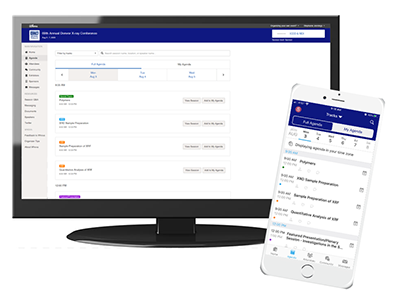
DXC Workshops

Each morning of conference week began with tutorial workshops. A total of 14 workshops, instructed by 32 specialists, provided video presentations and/or PDF handouts to eager attendees. Workshop instructors were available for live Question and Answer discussions during designated time slots, and continued to be available for private chats within the app. Topics were categorized as either XRD, XRF, or Special Topic, and focused on both beginner and advanced level topics.
Topics included:
Polymers
Thin Films
X-ray Optics
XRD Sample Preparation
Understanding your Diffractometer – Tips and Tricks
Stress Analysis
Two-Dimensional Detectors
Sample Preparation of XRF
Basic XRF
Micro XRF
Trace Analysis
Quantitative Analysis of XRF
Handheld XRF – The Silver Bullet or Fools Gold?
Multi-modal XRF Microscopy Fitting Tools
Plenary Session and Featured Presentations
The Plenary Session, Secrets of the Smithsonian and Library of Congress, was organized by Tom Blanton, ICDD, USA. One plenary talk premiered each day, Monday through Wednesday. Monday’s plenary talk was presented by Jeffrey Post of the Smithsonian Institution, Investigations in the Smithsonian Gem and Mineral Collection: Challenges and Opportunities. On Tuesday, Lynn Brostoff of the Library of Congress presented the talk, Cultural Heritage Science and the Material of Memory. Wednesday’s presentation concluded the plenary session with, Energy Dispersive X-ray Spectroscopy of 19th-Century Dental Fillings by Douglas Owsley and Timothy Rose, both of the Smithsonian Institution.
On Thursday and Friday of conference week, feature presentations were given by Bryan Wheaton of Corning, Inc., and Daniel Swetz of the National Institute of Standards and Technology. Dr. Wheaton spoke on, High Temperature X-ray Diffraction for Fundamental Understanding of Nucleation and Growth of Glass-Ceramics, and Dr. Swetz gave a talk on, The Modern Microcalorimeter: A Broadband, High Resolution, High Throughput Detector for the X-ray Sciences.
The Plenary speakers and featured presenters were all available for a one-hour live chat on the day that their presentation premiered on the app. Attendees took advantage of their presence and submitted many questions and comments for discussion.
Investigations in the Smithsonian Gem and Mineral Collection by Jeffrey Post
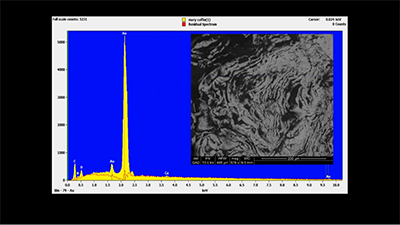
Energy Dispersive X-ray Spectroscopy of 19th-Century Dental Fillings by Douglas Owsley and Timothy Rose
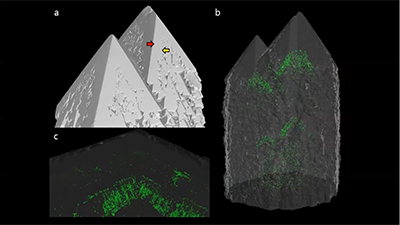
Cultural Heritage Science and the Material of Memory by Lynn Brostoff
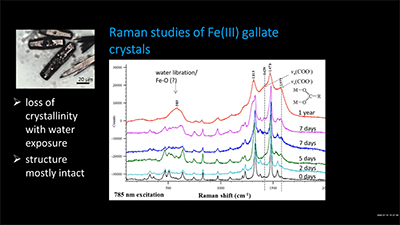
High Temperature X-ray Diffraction for Fundamental Understanding of Nucleation and Growth of Glass-Ceramics by Bryan Wheaton
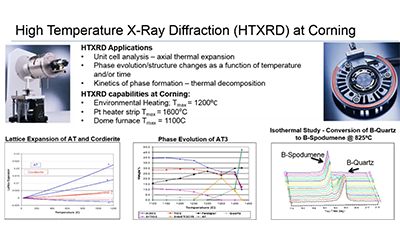
The Modern Microcalorimeter: A Broadband, High Resolution, High Throughput Detector for the X-ray Sciences by Daniel Swetz
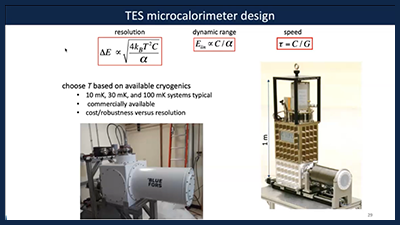
Special Sessions
Each afternoon, new oral sessions were released on the app, and attendees and presenters were given a three-hour window for live discussion.
Eighteen topics were covered during the special sessions:
New Developments in XRD & XRF Instrumentation
Cultural Heritage
Imaging
X-ray Absorption Spectroscopy
Polymers
Machine Learning Techniques in X-ray Analysis
Neutron Diffraction
Ceramics
General XRD
Rietveld
Materials for Energy and Sustainability Applications
Stress Analysis
Trace Analysis
General XRF
Quantitative Analysis of XRF
Advanced Fundamental Parameters
Food, Environment
Industrial Applications of XRD & XRF
Poster Sessions
Posters became available on Monday (XRD posters) and Tuesday (XRF posters) of conference week. Attendees were given the opportunity to study PDF versions of the electronic posters and a two-hour window was designated for live chats between presenters and attendees. Best poster awards were chosen; the following presenters were announced as winners (* indicates the presenter):
XRD Best Poster Awards:
S. Ichikawa* and T. Kurisaki, Fukuoka University, Japan, for their work:
Preliminary Examination for Elucidating Resource Dependency of d-spacing of Biotite for Provenance Estimation of Atamadai-Type Pottery (2500-1500 BC) with XRD
K. Sakurai*, National Institute for Material Science, Japan, N.D. Quang, Vietnam Atomic Energy Institute, Vietnam and H. Eba, Tokyo City University, Japan, for their work:
Versatile Chemical Handling Method to Confine Radioactive Cesium as Stable Inorganic Crystal: X-ray Evidence
S. Burns*, University of Calgary, Canada; D. Sando, R. Bulanadi, O. Paull, C. Lau, V. Nagarajan, UNSW Sydney, Australia; M. Gregg, Queen’s University Belfast, UK, for their work:
X-ray Diffraction in Determining Interface Energies in Mixed-Phase BiFeO3
XRD Best Student Poster Award:
N. Kaur*, V. Young, R. Suryanarayanan, University of Minnesota, USA and Y. Su, Merck & Co., Inc., USA, for their work:
Partial Dehydration of Levothyroxine Sodium Pentahydrate in a Drug Product Environment: Structural Insights into Stability
XRD Poster Awards
XRF Best Poster Awards:
J. Sedlmair*, Bruker AXS LLC, USA, for her work:
Low-level Elemental Analysis of Filters
T. Matsuyama*, T. Hayakawa, H. Yamaguchi and K. Tsuji, Osaka City University, Japan, for their work:
X-ray Analytical Techniques for Determining Trace Elements in a Single Human Hair and Atmospheric Aerosols
XRF Best Student Poster Awards:
C. Lutz* and U.E.A. Fittschen, Clausthal University of Technology, Germany, for their work:
Laboratory-based XANES to Study Vanadium in Vanadium Redox Flow Batteries
S. Sonoda*, T. Matsuyama, K. Tsuji, Osaka City University, Japan, and H. Nakano, Osaka City University and HORIBA Ltd. Research & Development, Japan, for their work:
Development of Confocal Line X-ray Fluorescence Instrument and Application to Layer Structure Samples
XRF Poster Awards
Exhibits and Sponsorships
Twenty-one virtual exhibits were included at the conference, with participating vendors displaying pre-recorded videos, live stream product presentations, and various promotional activities.
Companies providing virtual exhibits were:
Angstrom, Inc.
Bruker
DECTRIS Ltd.
Excillum, Inc.
Herzog Automation Corp.
Hitachi High Tech Science America, Ltd.
International Centre for Diffraction Data
KA Imaging
Malvern Panalytical
Materials Data
Moxtek, Inc.
Petrick GmbH
Premier Lab Supply
Proto
Rigaku
Shimadzu Scientific Instruments, Inc.
Specac, Inc.
STOE Corporation
Triple Ring Technology
XIA LLC
XOS
Many of the exhibitors also participated as sponsors. Bruker very generously sponsored the event app.

Other companies supporting the conference as sponsors included:
International Centre for Diffraction Data
Moxtek, Inc.
Petrick GmbH
Premier Lab Supply
Proto
Specac, Inc.
STOE Corporation
Triple Ring Technology
XIA
XOS
DXC Awards
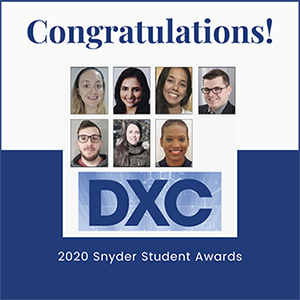
Although the Robert L. Snyder Student Award is customarily meant to aid student travel to DXC, for the virtual event, the awardees received waived registration to the conference.
The 2020 Robert L. Snyder Student Award winners were:
- Hannah Cross, Keele University, UK
- Navpreet Kaur, University of Minnesota, Twin Cities, USA
- Florencia Emilse Lurgo, Ciudad Universitaria, Argentina
- Christian Lutz, Clausthal University of Technology, Germany
- Marcelo Augusto Malagutti, Federal University of Santa Catarina, Brazil
- Ana Murrieta Muñoz, Tecnológico de Monterrey, Mexico
- Tashiema Ulrich, Los Alamos National Laboratory, USA
Virtual DXC Gets Social
Over 3,313 messages and 233 photos were shared within the DXC conference app. Clearly, this close-knit community of materials scientists had something important to share, and a world-wide crisis wasn’t about to stop them. Although everyone needed to remain physically distant, the X-ray community still found a way to be socially active during the virtual event.
The app’s “Community Board” was buzzing with networking opportunities. Attendees immediately created boards on fun topics like pets and playlists, while also sharing important information through article sharing and job postings. Virtual meet-ups were scheduled daily, including a coffee break and “happy half-hour” with the conference organizers.
Many participated in the “A View out Your Window” photo contest, with gorgeous pictures from around the globe. The winner of the contest was Adriana Rocha of Federal University of Rio de Janeiro. Adriana submitted a photo of a Black Beak Tucano bird that was hanging outside her home office in Brazil. Although the view was an everyday occurrence for Adriana, seeing a Tucano in its natural state is a sight most people will never experience.
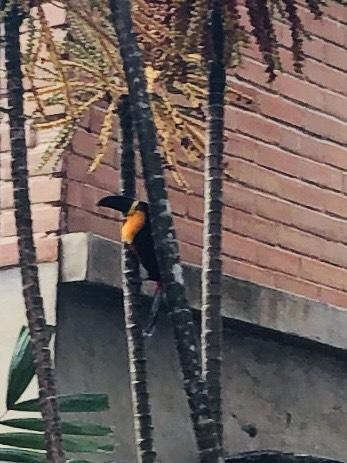
Thank You
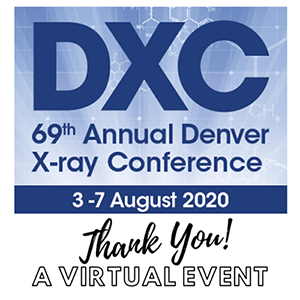
The Conference Services team at ICDD would like to thank the many people who volunteered their time and efforts to organize this amazing event in a very short period of time.
Members of the DXC Organizing Committee, Session Chairs, Workshop Instructors, Invited and Contributed Speakers, and Exhibitors all played a role in bringing the community together. Special thanks also to all the attendees who registered for the event and actively involved themselves in the app.
Instead of focusing on the many things that couldn’t be done, everyone moved forward with positivity and creativity and found a way to reunite. The success of the event is attributed to each and every individual who participated, and we send our heartfelt thanks to all of you!
Website, Abstracts, and Proceedings
To view the complete DXC Program, including abstracts, please visit the Program page of the conference website. The DXC conference proceedings, Advances in X-ray Analysis (AXA), Volume 64, will be published in the summer of 2021. Select AXA papers will also be published in Powder Diffraction Journal. Please visit the “Resources” page of the ICDD website for free access to manuscripts published in Volumes 40 through 62 of Advances in X-ray Analysis.
2021 Meeting
Although the future is uncertain, DXC organizers are moving forward with plans for a physical conference in 2021 at The Westin Chicago Lombard, Yorktown Center, Lombard, Illinois, USA from 2 – 6 August. We hope to be back together again in 2021!